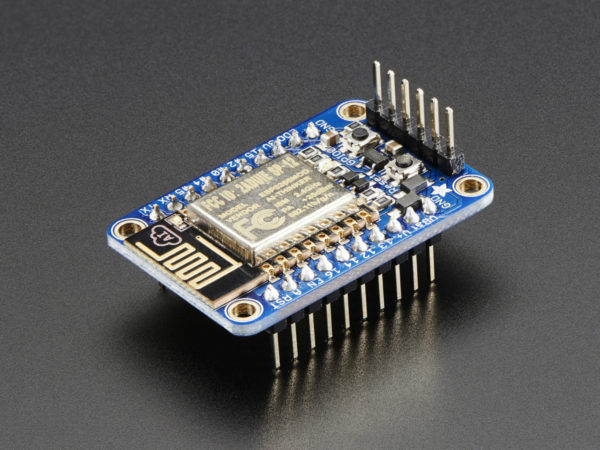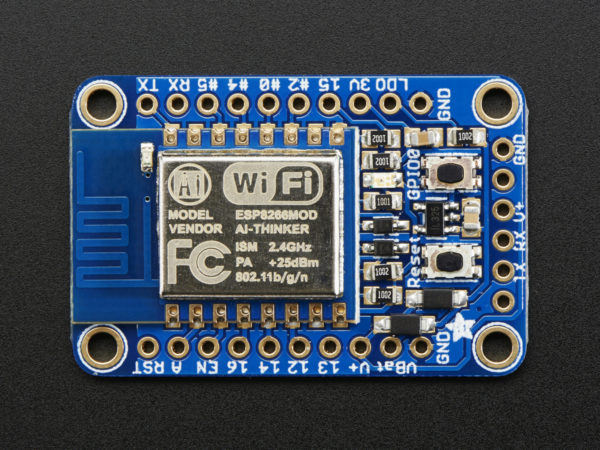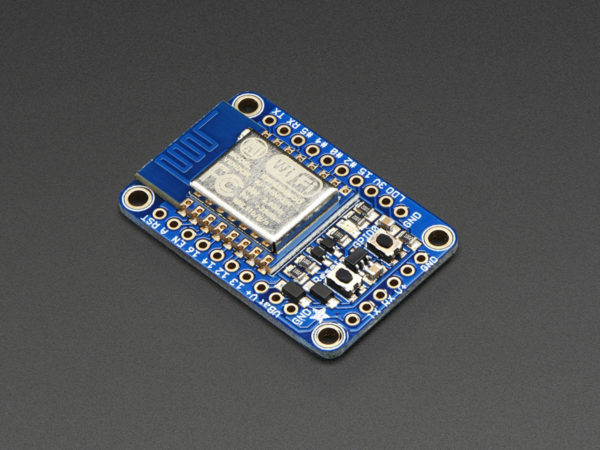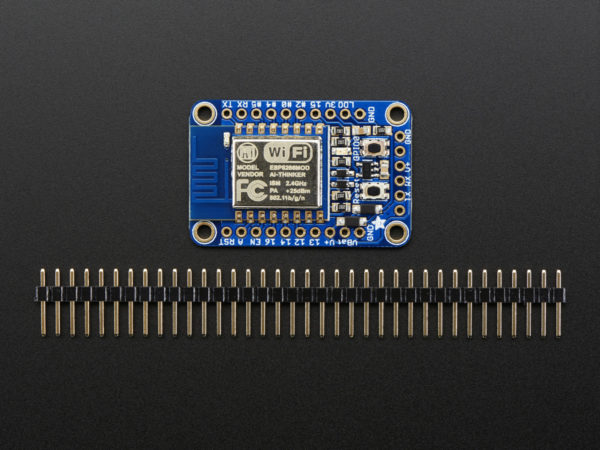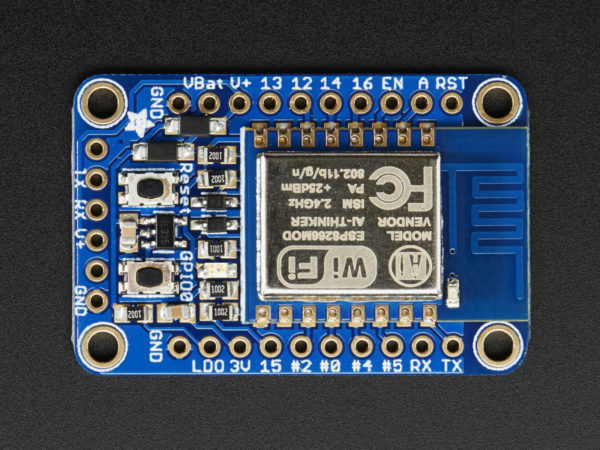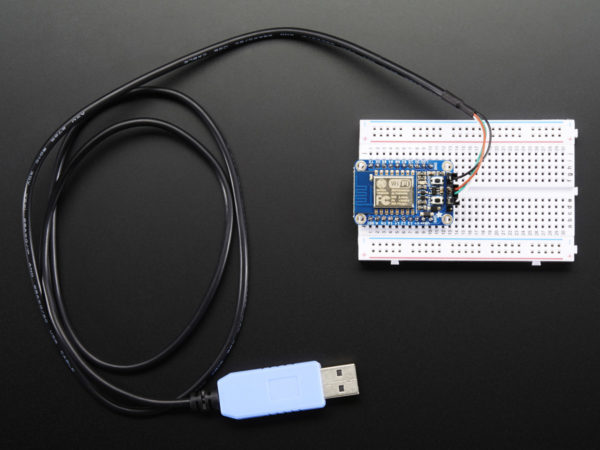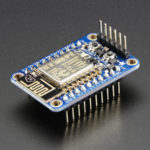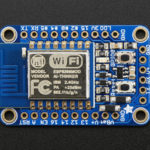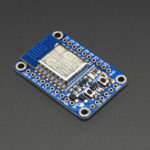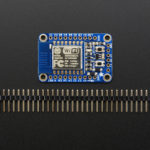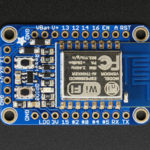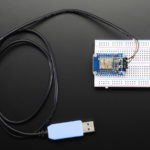Adafruit HUZZAH ESP8266 Breakout
13,93 €
The ESP8266 is a System On Chip, equipped with a microcontroller clocked at 80MHz and WiFi (both client and access point) with TCP / IP stack and DNS support. The Adafruit HUZZAH ESP8266 mounts a module with the ESP8266 together with a reset button, a programmable button that can also activate the bootloader, a red LED, a logic converter on the UART and on the reset pin, a regulator from 3.3V to 500mA (ESP8266 requires up to 250mA), two diodes to protect USB and battery. Two parallel rows of breadbord friendly headers allow access to an analog input (1.8V max), 9 GPIO (3.3V logic) which can also be used for I2C and SPI, 2 pins UART, 2 x 3-12V power inputs, reset, enable, LDO-disable and 3.3V output. There is also a breakout for the FTDI cable or the console cable, useful for uploading software or debugging via UART. Each module has been precarious with the NodeMCU Lua interpreter, but can be used directly with Arduino IDE. In the description you will find all the useful links.
- Description
- Product information
Description
Add Internet to your next project with an adorable, bite-sized WiFi microcontroller, at a price you like! The ESP8266 processor from Espressif is an 80 MHz microcontroller with a full WiFi front-end (both as client and access point) and TCP / IP stack with DNS support as well. While this chip has been very popular, its also been very difficult to use. Most of the low cost modules are not breadboard friendly, don't have an onboard 500mA 3.3V regulator or level shifting, and aren't CE or FCC emitter certified… .UNTIL NOW!
The Adafruit HUZZAH ESP8266 breakout is what we designed to make working with this chip super easy and a lot of fun. We took a certified module with an onboard antenna, and plenty of pins, and soldered it onto our designed breakout PCBs. We added in:
Reset button,
User button that can also put the chip into bootloading mode,
Red LED you can blink,
Level shifting on the UART and reset pin,
3.3V out, 500mA regulator (you'll want to assume the ESP8266 can draw up to 250mA so budget accordingly)
Two diode-protected power inputs (one for a USB cable, another for a battery)
Two parallel, breadboard-friendly breakouts on either side give you access to:
1 x Analog input (1.8V max)
9 x GPIO (3.3V logic), which can also be used for I2C or SPI
2 x UART pins
2 x 3-12V power inputs, reset, enable, LDO-disable, 3.3V output
One breakout at the end has an “FTDI” pinout so you can plug in an FTDI or console cable to upload software and read / write debugging information via the UART. When you're done with your coding, remove the cable, and this little module can be embeded into your project box.
Each module comes pre-loaded with NodeMCU's Lua interpreter (NodeMCU 0.9.5 build 20150318 / Lua 5.1.4 to be specific), you can run commands, and 'save' Lua programs directly to the module's Flash using a USB-Serial converter cable . But, if you'd like, you can skip Lua and go direct to using the Arduino IDE. Once you download the ESP8266 core, you can treat it just like a microcontroller + WiFi board, no other processors needed!
Each order comes with one assembled and tested HUZZAH ESP8266 breakout board, and a stick of 0.1 ″ header that you can solder on and plug the breakout into a breadboard. A soldering iron and solder are required for that, and aren't included. Solderless breadboard also not included. You'll really want a USB-serial cable such as a USB console cable (not suggested for MacOSX users), FTDI Friend, or FTDI cable (3 or 5V power / logic is fine) to upload software to the HUZZAH ESP8266! Our essential tutorial has wiring, pinouts, assembly, downloads, and more!
Dimensions: 25mm x 38mm x 5mm / 1 ″ x 1.5 ″ x 0.2 ″
Weight: 5g
Pre-programmed with NodeMCU 0.9.5 build 20150318 (Lua 5.1.4)
ESP8266 specification sheet
FCC test report for the module used on this breakout (Contains FCC ID: 2ADUIESP-12)
CE test report for the module used on this breakout
Huuuuge amount of information on http://www.esp8266.com/ community forum!
NodeMCU (Lua for ESP8266) webpage with examples and documentation on the Lua framework
Arduino IDE support for ESP8266
Don't forget to visit esp8266.com for the latest and greatest in ESP8266 news, software and gossip!
You may get a blue or black module, they are identical.
Product information
| Weight | 0,05 kg |
|---|---|
| Length | 5x1x3 cm |
| BRAND | Adafruit |

